Our official English website, www.x-mol.net, welcomes your feedback! (Note: you will need to create a separate account there.)
Covalent stabilization of copper porphyrin into carbon nitride for the catalytic reduction of CO2
Journal of Catalysis ( IF 6.5 ) Pub Date : 2024-06-06 , DOI: 10.1016/j.jcat.2024.115597 Claudio Cometto , Giulia Marafon , Verónica Celorrio , Gonzalo García , Steffi Y. Woo , Enrico Paron , Alberto Zobelli , Gregorio Bottaro , Lidia Armelao , Elena Pastor , Alessandro Moretto , Laura Calvillo
Journal of Catalysis ( IF 6.5 ) Pub Date : 2024-06-06 , DOI: 10.1016/j.jcat.2024.115597 Claudio Cometto , Giulia Marafon , Verónica Celorrio , Gonzalo García , Steffi Y. Woo , Enrico Paron , Alberto Zobelli , Gregorio Bottaro , Lidia Armelao , Elena Pastor , Alessandro Moretto , Laura Calvillo

|
The development of active, selective, and durable (photo)electrocatalytic hybrid systems by combining molecular catalysts and semiconductor substrates is crucial for efficiently converting solar light into high-value products. Herein, a one-step synthesis method to obtain carbon nitride (CN) nanosheets, which allows the direct covalent polymerization with molecular catalysts, was developed. Copper-porphyrin (CuPor) units were embedded in the CN structure as a case-study. The single and hybrid materials were fully characterized by combining microscopic and spectroscopic techniques and tested as (photo)electrocatalysts for the CO reduction reaction (CORR) in aqueous solution. Experimental evidence confirmed an effective boost of the CN photoelectrocatalytic activity by introducing the CuPor units. Formate was identified as the only CORR product on both CuPor and CuPor-CN, simultaneously with hydrogen from the competitive hydrogen evolution reaction. However, the formate/hydrogen ratio was higher when the hybrid material was used as catalyst, suggesting a synergetic effect between CuPor and CN, that favors the CORR and hinders the HER. In addition, the stability of the CuPor units in the CN matrix under catalytic conditions was studied by X-ray absorption. No changes of the Cu porphyrin structure or formation of copper clusters/nanoparticles was observed as a function of the applied potential nor after an accelerated ageing treatment, suggesting that the CN matrix is able to stabilize the Cu sites avoiding their agglomeration.
中文翻译:

铜卟啉共价稳定成氮化碳用于催化还原 CO2
通过结合分子催化剂和半导体基底来开发活性、选择性和耐用的(光)电催化混合系统对于有效地将太阳光转化为高价值产品至关重要。在此,开发了一种获得氮化碳(CN)纳米片的一步合成方法,该方法允许与分子催化剂直接共价聚合。作为案例研究,铜卟啉 (CuPor) 单元嵌入 CN 结构中。通过结合显微镜和光谱技术对单一和混合材料进行了充分表征,并作为水溶液中 CO 还原反应 (CORR) 的(光)电催化剂进行了测试。实验证据证实引入CuPor单元可以有效提高CN光电催化活性。甲酸被确定为 CuPor 和 CuPor-CN 上唯一的 CO2RR 产物,同时还有来自竞争性析氢反应的氢气。然而,当杂化材料用作催化剂时,甲酸盐/氢气比较高,这表明CuPor和CN之间存在协同效应,有利于CO2RR并阻碍HER。此外,通过X射线吸收研究了催化条件下CN基质中CuPor单元的稳定性。没有观察到铜卟啉结构或铜簇/纳米颗粒的形成随施加电位的变化或在加速老化处理后的变化,这表明 CN 基质能够稳定铜位点,避免其团聚。
更新日期:2024-06-06
中文翻译:

铜卟啉共价稳定成氮化碳用于催化还原 CO2
通过结合分子催化剂和半导体基底来开发活性、选择性和耐用的(光)电催化混合系统对于有效地将太阳光转化为高价值产品至关重要。在此,开发了一种获得氮化碳(CN)纳米片的一步合成方法,该方法允许与分子催化剂直接共价聚合。作为案例研究,铜卟啉 (CuPor) 单元嵌入 CN 结构中。通过结合显微镜和光谱技术对单一和混合材料进行了充分表征,并作为水溶液中 CO 还原反应 (CORR) 的(光)电催化剂进行了测试。实验证据证实引入CuPor单元可以有效提高CN光电催化活性。甲酸被确定为 CuPor 和 CuPor-CN 上唯一的 CO2RR 产物,同时还有来自竞争性析氢反应的氢气。然而,当杂化材料用作催化剂时,甲酸盐/氢气比较高,这表明CuPor和CN之间存在协同效应,有利于CO2RR并阻碍HER。此外,通过X射线吸收研究了催化条件下CN基质中CuPor单元的稳定性。没有观察到铜卟啉结构或铜簇/纳米颗粒的形成随施加电位的变化或在加速老化处理后的变化,这表明 CN 基质能够稳定铜位点,避免其团聚。












































 京公网安备 11010802027423号
京公网安备 11010802027423号